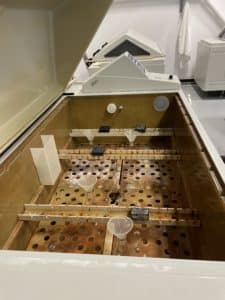Cyclic Corrosion Testing

Research indicates that using cyclic corrosion testing results in the relative corrosion rates, structure and morphology that are more similar to those observed outdoors. Consequently, this approach usually gives a better correlation to outdoor environmental conditions than conventional salt spray tests. Cyclic corrosion tests are effective for evaluating a variety of corrosion mechanisms, including general, galvanic, and crevice corrosion.
There are many ways to test for corrosion resistance using cyclic corrosion including the ASTM G85 test, ASTM G44 test and the ASTM D5894 test.
This improved accelerated corrosion technique is intended to produce material degradation and failures representative of the type found in outdoor corrosive environments. Simple exposures like prohesion may consist of cycling between salt fog and dry conditions. More sophisticated automotive methods call for multi-step cycles that incorporate immersion, humidity, condensation, along with salt fog and dry-off.
Cyclic Corrosion Testing in Automotive Industry
The automotive industry has taken the lead in researching cyclic corrosion tests (CCT). Consequently, most of the procedures are geared toward automotive applications.
According to the research done by the SAE ACAP Committee and the AISI, GM 9540P/B is currently considered one of the preferred cyclic corrosion test methods for automotive cosmetic corrosion (painted or precoated metals). GM9540P/B requires an automatic cycling test chamber just like the one Micom Laboratories uses. Our automated cyclic corrosion can run the GM9540P/B exposure conditions and many other automotive industry cycles:
GM 9540P/B Cycle
- Electrolyte Solution 0.9% NaCl, 0.1% CaCl2 & 0.25 NaHCO3
- Solution Acidity pH between 6.0 and 8.0.
- Typical Durations 80 cycles (1,920 hours)
- Thorough Salt Mist Application
- 90 minutes Ambient Conditions (25°C, 30 – 50% RH)
- Thorough Salt Mist application
- 90 minutes Ambient Conditions (25°C, 30 – 50% RH)
- Thorough Salt Mist application
- 90 minutes Ambient Conditions (25°C, 30 – 50% RH)
- Thorough Salt Mist application
- 210 minutes Ambient Conditions (25°C, 30 – 50% RH)
- 8 hours Humidity (95 – 100% RH)
- 8 hours Dry Off (60°C, <30% RH)
- Repeat
CCT-4 Japanese Automotive Cyclic Corrosion Testing
CCT-4 is specified by some Japanese automotive manufacturers. In the SAE and AISI research projects, CCT-4 was shown to be one of the exposures that best correlated with actual vehicle corrosion results.
The exposure conditions include:
- Electrolyte Solution 5% sodium chloride
- Solution Acidity not specified
- Typical Duration 50 cycles (1,200 hours)
The CCT-4 exposure cycle is:
- 10 minutes Salt fog application at 35°C
- 155 minutes Dry Off at 60°C
- 75 minutes Humidity at 60°C, 95% RH
- 160 minutes Dry Off at 60°C
- 80 minutes Humidity at 60°C, 95% RH
- 160 minutes Dry Off at 60°C
- 80 minutes Humidity at 60°C, 95% RH
- 160 minutes Dry Off at 60°C
- 80 minutes Humidity at 60°C, 95% RH
- 160 minutes Dry Off at 60°C
- 80 minutes Humidity at 60°C, 95% RH
- 160 minutes Dry Off at 60°C
- 80 minutes Humidity at 60°C, 95% RH
- Repeat
Other Related Test Methods
For additional test methods related to cyclic corrosion testing, we invite you to learn more about ASTM B117, Surface Coatings, and Accelerated Aging.
If you have any questions about cyclic corrosion testing, we invite you to contact us today. It will be our pleasure to help you with your custom cyclic corrosion testing requirements.

